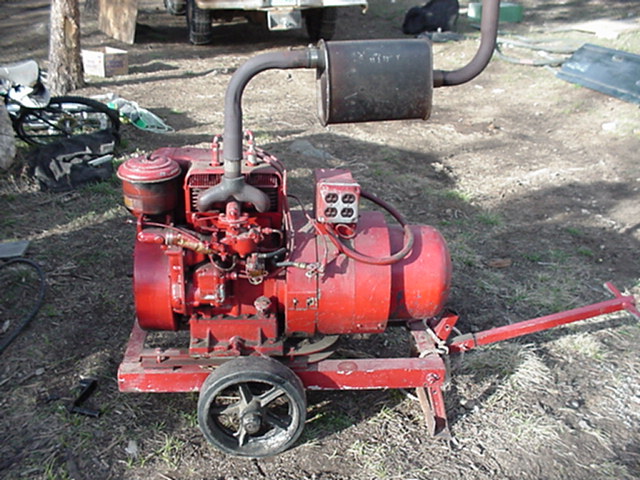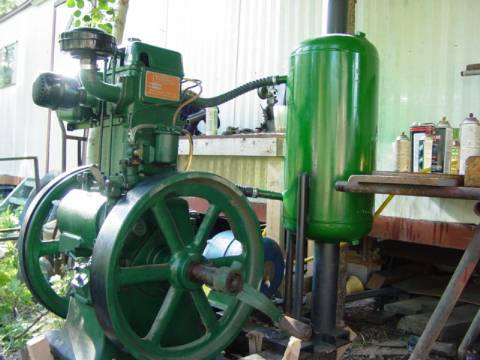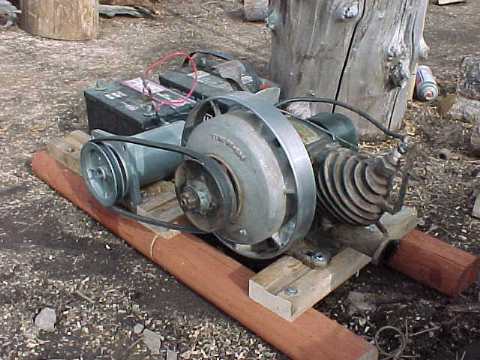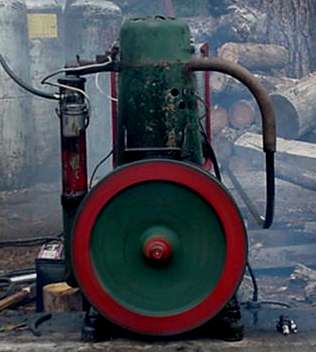Alternative energy is expensive compared to grid power. A renewable energy system that meets your needs 90% of the year could cost a fraction as much as the system that will always provide more energy than you need. Even with an excellent solar array and wind power supplement, there will be times when the sun doesn't shine for weeks, and the wind won't blow. In order to keep your batteries from cycling too much, a fossil-fuel backup is usually wise. On this page we'll show some systems at work.
A good gas backup should be quiet, reliable, and efficient. Unfortunately...this sort of machine is very difficult to find these days. Only in the last couple of years has anyone put effort into building a commercial generator designed specifically for charging batteries. This is surprising considering how much research and development has gone into solar panels, windmills, etc. Most generators today are designed to run 120VAC appliances; most of them are loud, and all the affordable ones are lightweight, cheap, and not designed for the long haul. Using a normal 120VAC generator to charge batteries is terribly expensive, requires frequent maintenance, is generally loud, and not very efficient.
A generator's rated RPM is very important! Fast-spinning generators will always be noisier and less reliable, and will not last as long. A typical small generator from the hardware store runs at 3600 RPM. A more expensive model will run at 1800 RPM. Some older designs (and homebuilt models) run at 650 RPM -- amazingly quiet and reliable.
There are a few alternatives to a cheap hardware store generator....
Find an antique, or a 'new antique'.

Big Red, DanF's old Wisconsin 2-cylinder 1800 RPM generator. She's slow, quiet, powerful, heavy and reliable.
DanF got this beautiful old Wisconsin from a local pawnshop for only $200 in 2003. It had been there a year priced at $1200, then $900. It sat so long they couldn't get it started any longer and cut the price to $200. DanB was (fortunately) with DanF at the time, and said there wasn't much that could be really wrong with it, since it wasn't siezed. It is very heavey and was difficult to load onto the pickup truck. Sure enough, the only repairs needed were to drain the cruddy gas out of the tank, and make a new seal out of silicone for the glass bell sediment trap in the fuel line. The gasket has crumbled, and there is a fuel pump involved -- so any small air leak and it won't run. Big Red started right up after we made this repair!
Big Red has performed admirably for over a year now. All the components (spark plug wires, etc.) are waterproof military grade. It probably saw previous service in the military, or as the power source for the salt and sand spreader on the back of a big snowplow truck. At 1800 RPM, it's very quiet. It does not have the electric start option installed, starting is with a crank. It usually starts on 1/2 a crank, after priming the fuel pump with the built-in lever. It does use a bit of gas, but DanF has a big 75 amp Todd battery charger, and usually runs other appliances (washing machine, vacuum cleaner, etc.) while Big Red is running. The fuel pump will probably be the first thing to go, but Wisconsin parts are readily available. DanF had some problems with it summer 2004, but DanB tracked them down to bad gas (water in it) and gunk that clogged the fuel pump...just disassembling the fuel system, cleaning the carbuerator and fuel pump, and putting it back together again fixed it. DanB confirmed this because it ran fine with the fuel pump removed from the line, using gravity feed from an elevated gas can.
DanF loves Big Red -- it is so very quiet compared to his last, 4000 watt cheap 3600 RPM generator, and charges his battery bank much more quickly. We live at 8200 feet elevation, and there is significant power loss from the altitude up here. The generator that came with Big Red is rated at 7500 watts.
Old Lightplants
It should not be difficult for most folks with some mechanical inclination to find an old lightplant, restore it to usable condition, and make good use of it for many years. Keep in mind, most of these antique lightplants were built for daily use. Properly maintained, they could run a lifetime with very little trouble. Check out DanB's 1930's Delco below...
<Save this link for an MPEG movie of this charger running>
Delco made lots of these in the 20's and 30's. When I got mine, it was seized. The cylinder and valves looked like they came from the bottom of a lake! I spent one afternoon beating the piston loose, lapping the valves, and making other small modifications. It runs well now - although it could certainly use a good valve job. Although this machine was designed for 32 volts, it starts and runs well on 12 or 24 volts. Mine runs well on gasoline, but seems to prefer kerosene, or diesel. Its good for about 25 amps at 12 volts, and consumes a little over 1 pint of fuel per hour( a little less with kerosene, a little more with gasoline). Surprisingly, it seems to run best of all on citronella tiki lamp oil, which is probably mostly kerosene. And we've had no mosquitos around for months now! Electric start makes it convenient. It runs slow, under 1000 rpm, so with a good tailpipe and muffler, it's very peaceful to have running. It weighs in somewhere around 300-400 pounds, and the size of the castings/bearings/brushes etc. almost guarantee that it should run, and stay put, forever.
A 'new antique' Diesel generator

DanB's brand new FuKing Lister CS diesel engine clone from India, hooked to a Winco 5kw Ac generator head.
This engine can really be called a 'new antique.' Lister of England made these from 1930 to 1987, and many companies in India build inexpensive clones. They are running irrigation systems and light plants all over India. DanB got his from George at Utterpower.com, a heckuva nice guy who is an expert on these engines, and imports them into the USA. The quality varies by manufacturer, and George's website has tons of information about which makers have the best engine. The price is very cheap compared to any other diesel engine available, and it runs at only 650 RPM. It's incredibly quiet, and takes it's fuel in tiny sips....very economical, and it may last forever. It would run just fine on pure biodiesel. You should enjoy tinkering with engines if you want to go this route -- you'll need to fabricate an engine mount and a cooling system for it. DanB used an old Winco 5kw generator head for it, and George sells some really nice generator heads for it too.

Simple maytag engine battery charger
Build your own!
Something as simple as a small lawnmower engine belted to a car alternator can do a wonderful job of charging batteries very efficiently. Most lawnmower engines have crummy mufflers...this is real important, noise pollution is intolerable. It is best to use an oversized engine...run it slow and gear up the alternator. It will run quieter, and last longer. 5-10 horsepower is a good match for a 30-50 amp alternator. Home Power Magazine has had some excellent articles about building one of these. There's another excellent article on how to build one at TheEpicenter.com.
Buy a New Dedicated Gas Battery Charger
These chargers are a commercial version of the home built model we discussed above. Unfortunately, as of 2/16/2005 we don't know of any manufacturers. The ones we linked to here before are gone or longer making them. Let us know if you are aware of a source.
Buy a normal generator
The least desirable option in our opinion, but may be your only choice if you have a 220 volt AC well pump or do not have time to work on an antique or build your own.

